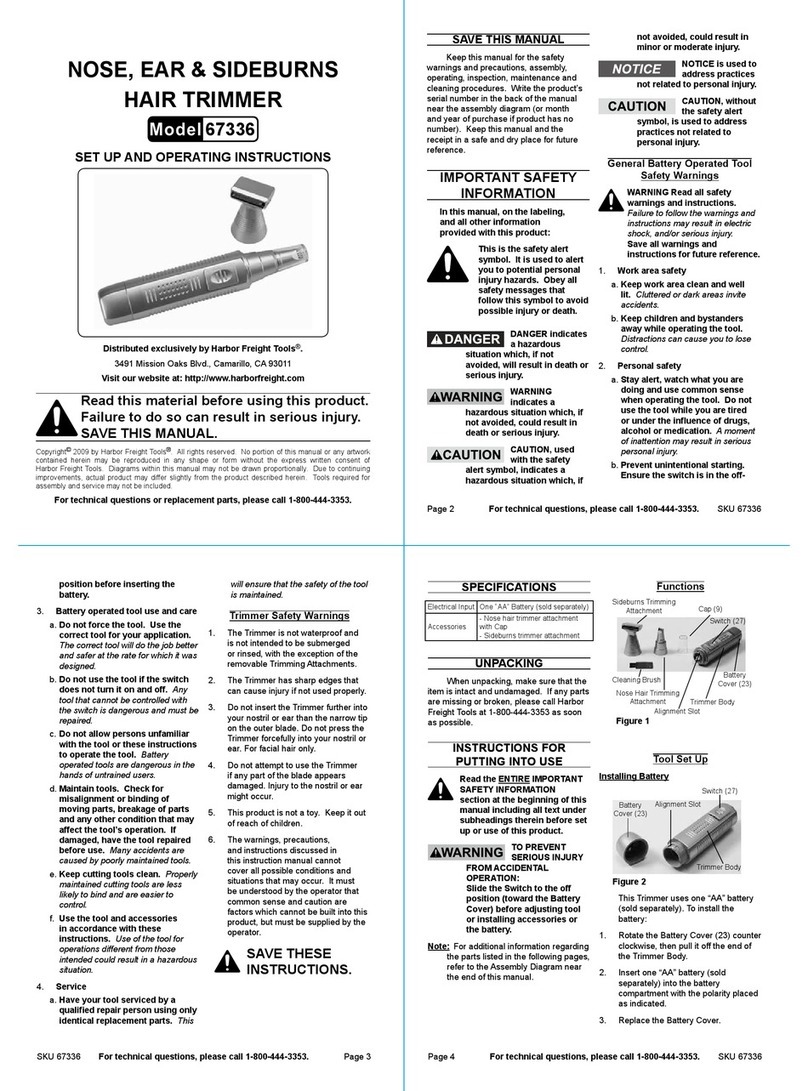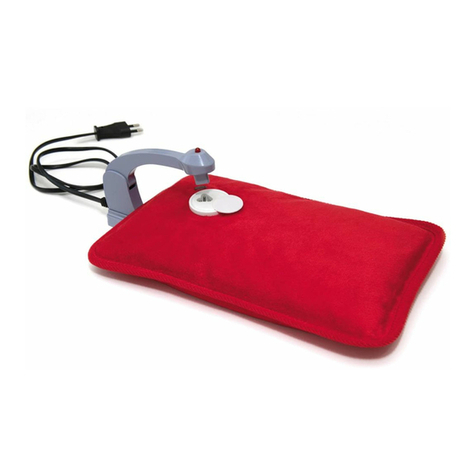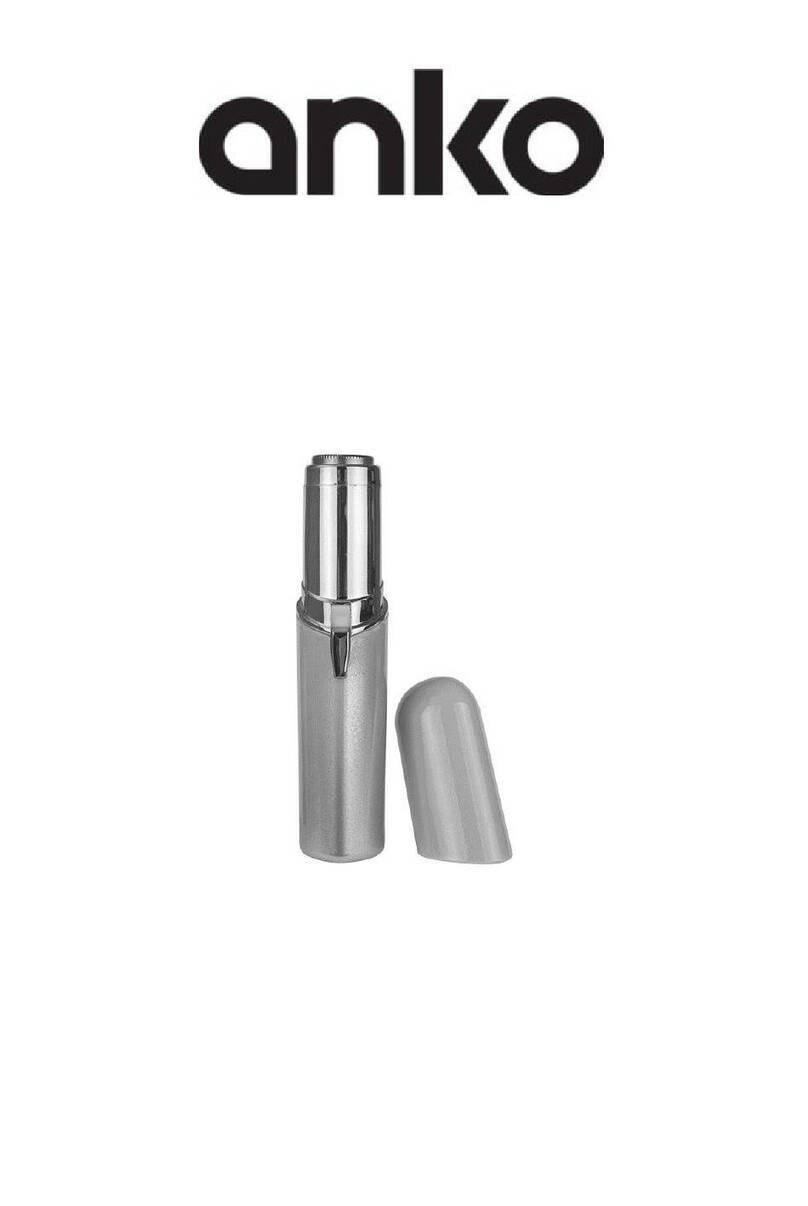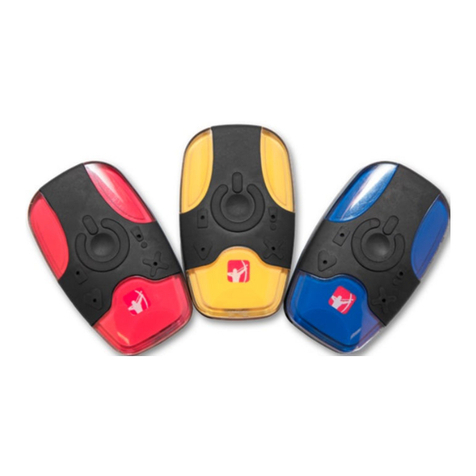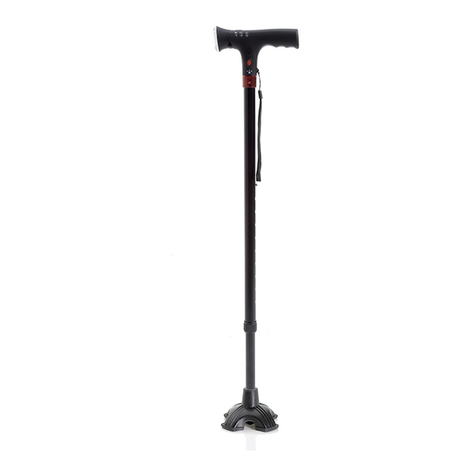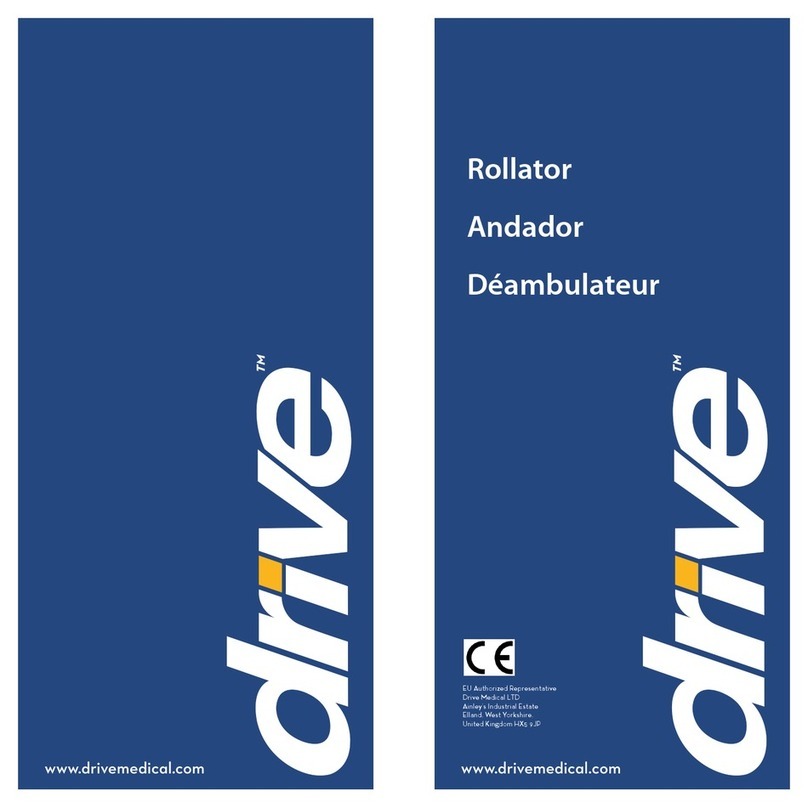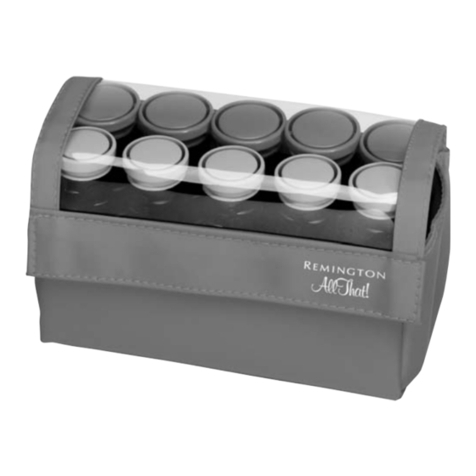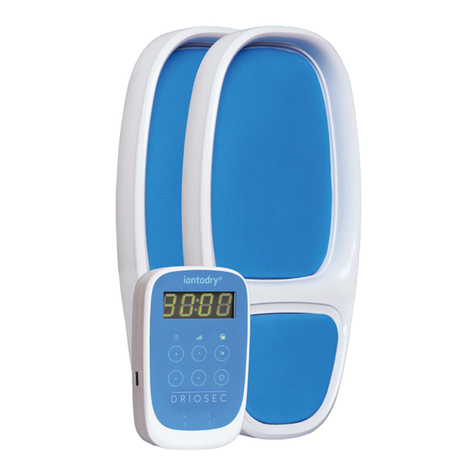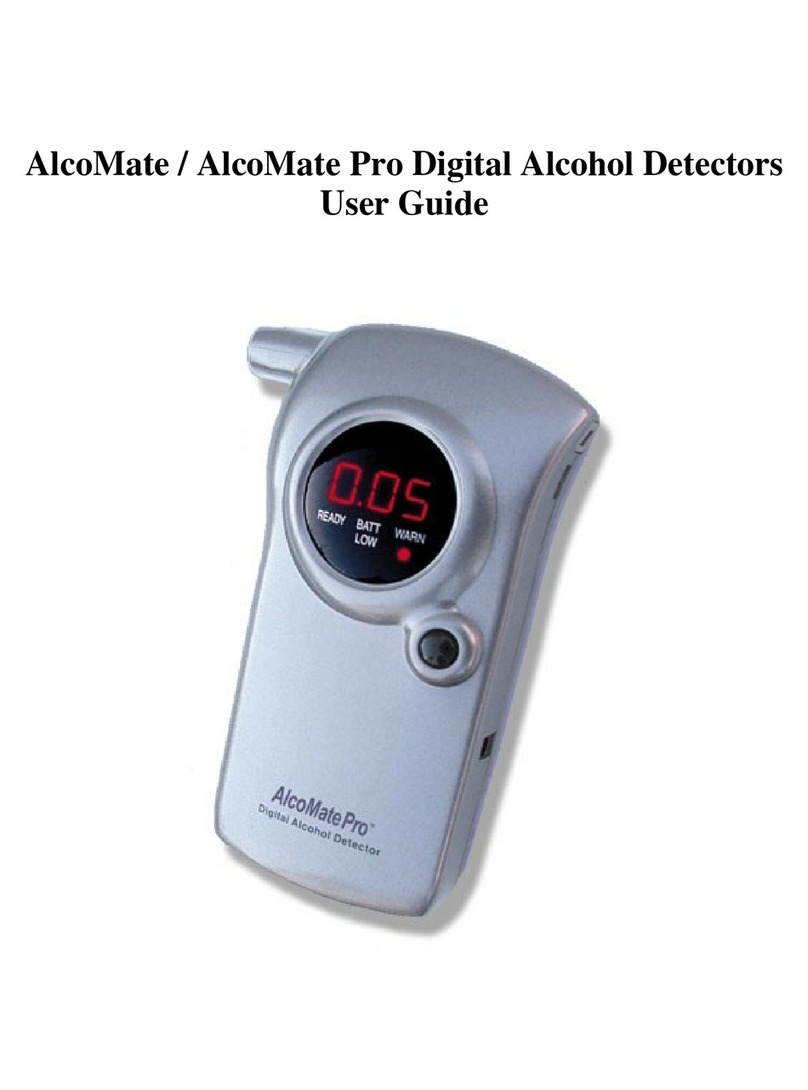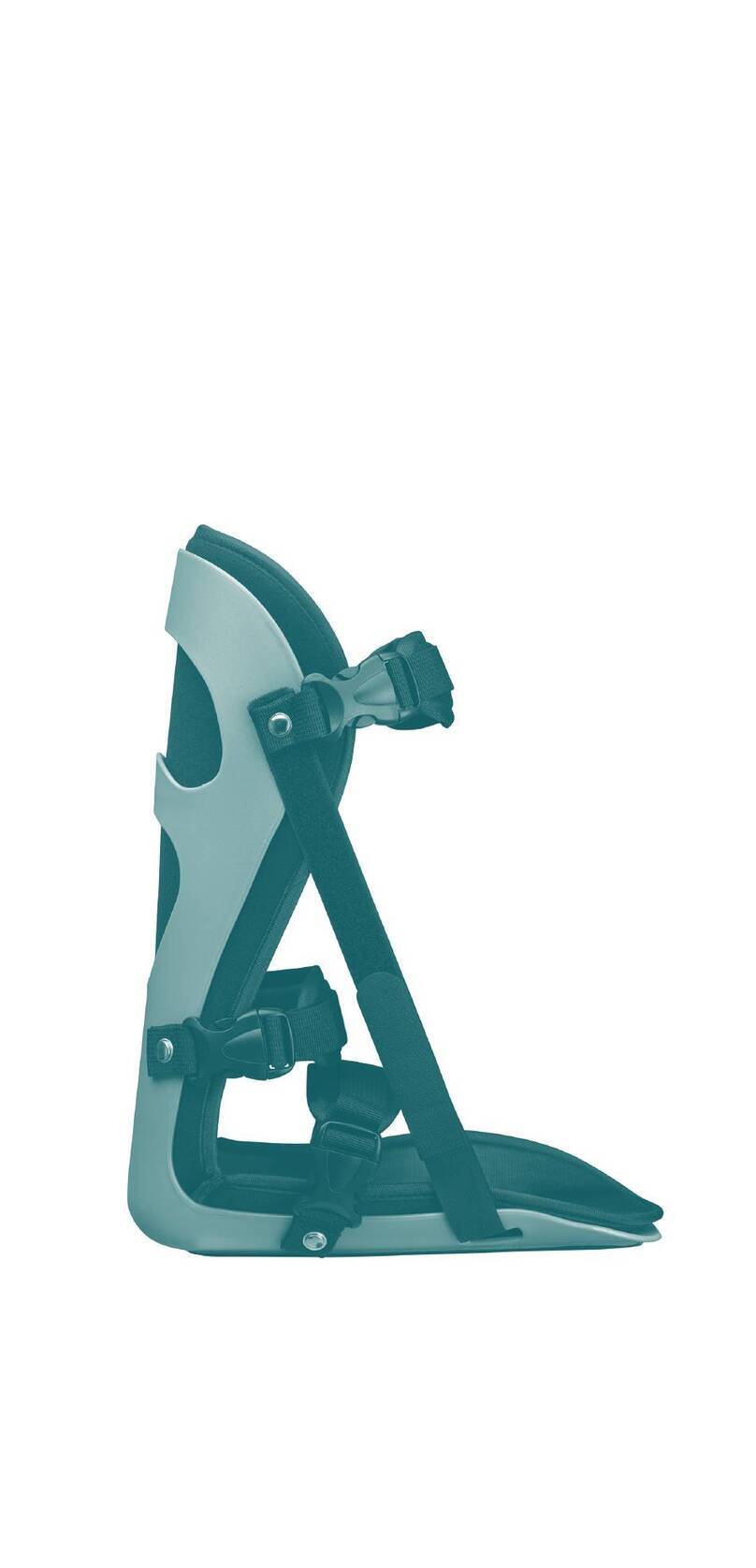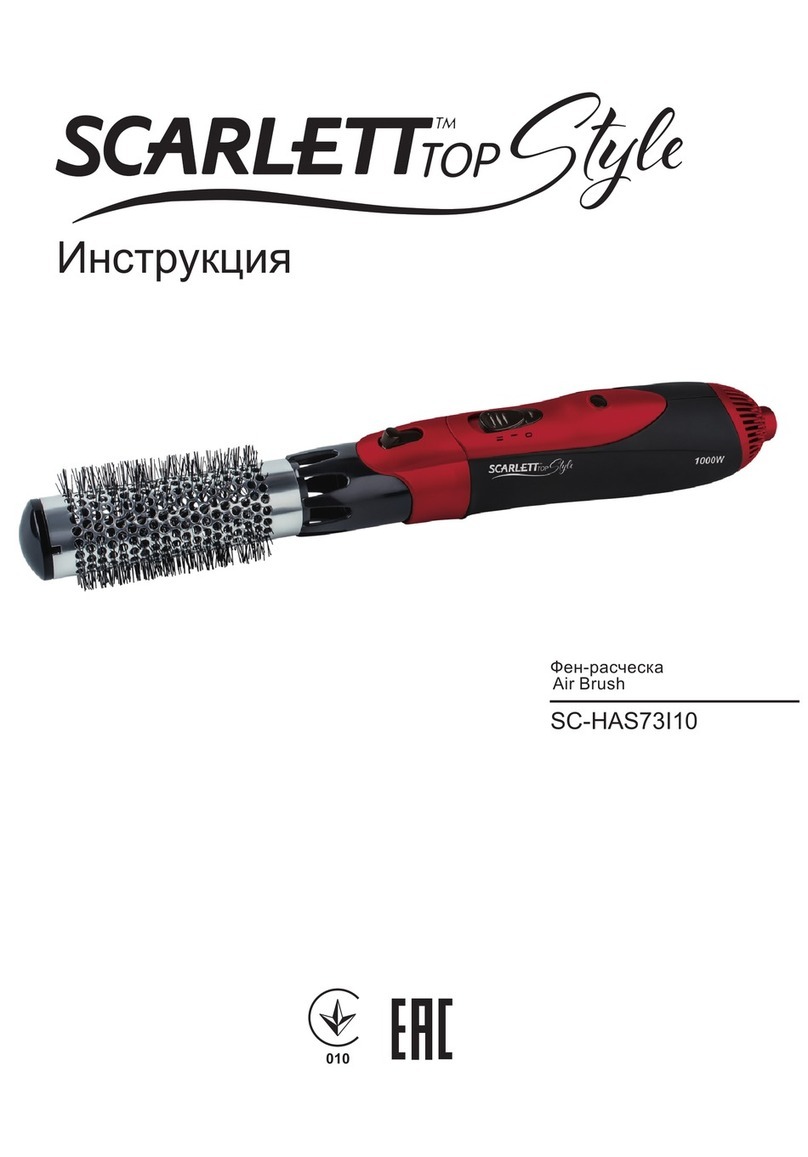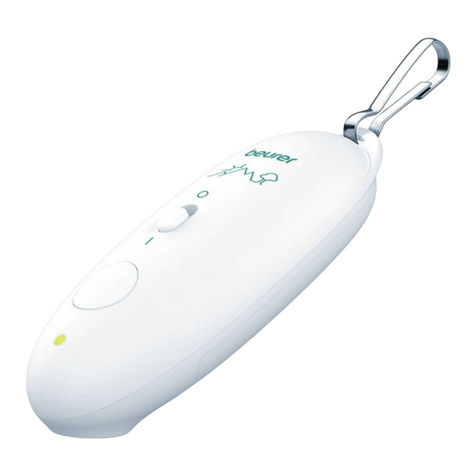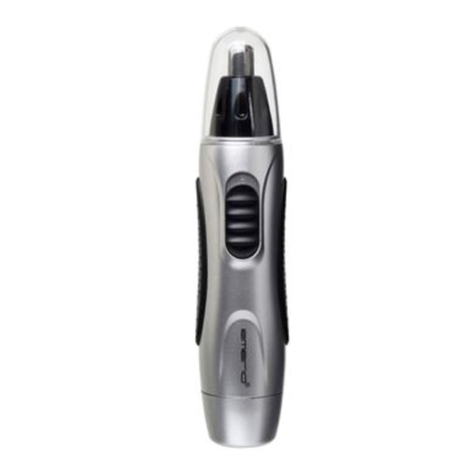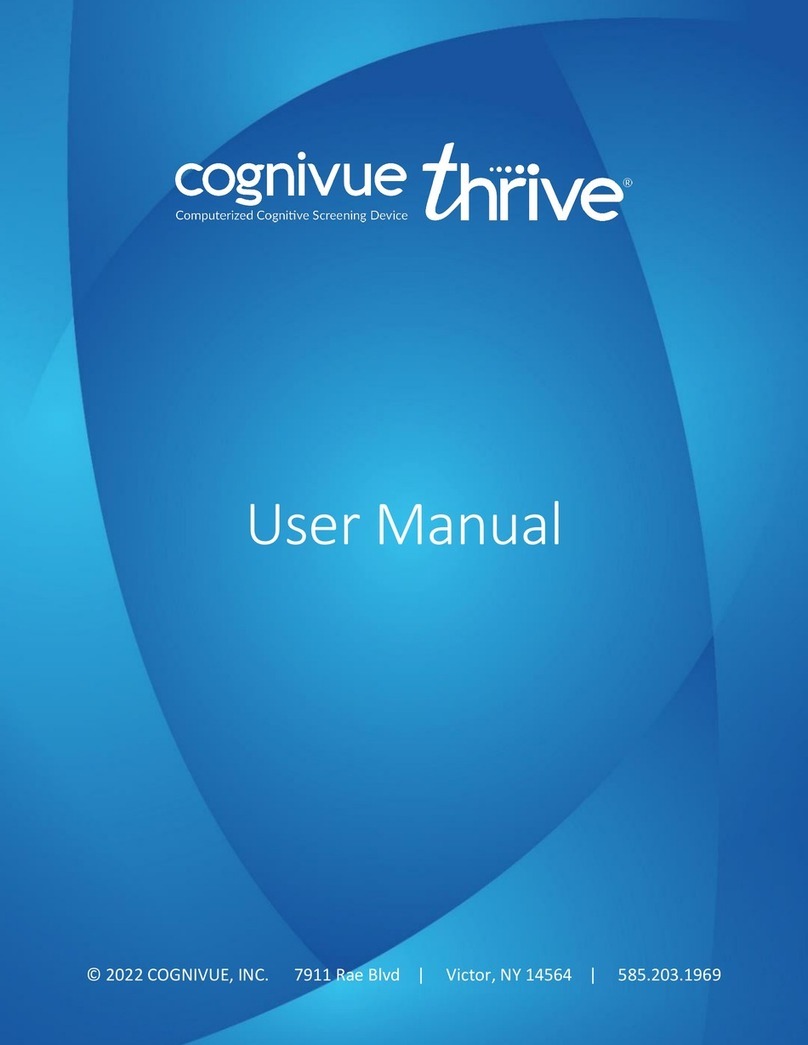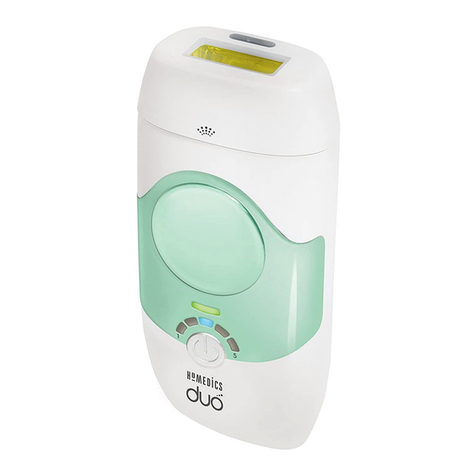Firstkind Firefly T-1 User manual

c
b
a
T-1
instructions for use T-1
7. If you are going to engage in physical activity while
wearing the rey™ T-1 device, Firstkind recommends
the use of a rey™ knee strap (purchased separately) to
ensure that the device remains in place on the leg. See
the instructions below for tting the knee strap.
a) Place the strap over the device with the strap buckle
positioned at the front of the leg and the rey™ T-1
device button showing through the strap hole.
b) Wrap the long end of the strap around the back of
the leg and secure the main, wider part of the strap
over the short end using the Velcro fastening material.
c) Thread the end of the long strap through the buckle
then return the long end to the back of the knee and
secure with the Velcro fastening tab.
d) Be sure that the strap is comfortable and not tight.
WARNING: The rey™ strap is made from a synthetic
rubber known as Neoprene (polychloroprene) with a
Nylon (polyamide) cover, which are both commonly
used in other sports devices such as wetsuits and knee
braces. Neoprene and Nylon both have the potential to
cause skin irritation or allergic type skin reactions. Do
not use the rey™ strap if you have previously
experienced a skin reaction to Neoprene or Nylon. If
you experience an itching skin rash or irritation when
wearing the strap, remove the strap immediately,
consult with your medical practitioner, and report the
incident to Firstkind Limited.
5
+
–
1
FIBULA
TIBIA
FIBULA HEAD COMMON
PERONEAL
NERVE
32 4
Fitting and operating instructions
1. Before attaching the rey™ T-1 device, you must
rst nd and prepare the location where the device
is to be secured. When the marker line on the device is
placed over the center of the bula head, the negative
electrode of the device will be over the common
peroneal nerve in the optimum position for stimulation.
The bula head can be found on the outside of the leg,
just below the level of the knee. The bula head can be
felt as a round protrusion at the very top of the bula
bone, which runs down the outside of the lower leg.
If you are unsure how to locate the bula head or the
common peroneal nerve, see www.reyrecovery.com
for further advice.
2. It is important that the rey™ T-1 electrodes be
applied to clean, dry skin in order to achieve optimum
muscle contractions. Wash the skin behind your knee
using a washcloth with mild soapy water, rinse, and dry
thoroughly. Do not apply any moisturizer. Any excess
hair in the area of application may be removed using
trimmers or clippers, but avoid shaving the skin as this
may increase the risk of skin irritation from the rey™
T-1 device electrodes or adhesive.
3. Peel o the protective lm and secure the device to
a straight leg so that the raised indicator line on the
device (marked with arrows) is positioned at the center
of the bula head. The head of the device should be
positioned towards the front of the leg – with the tail
of the device wrapped around and to the rear of the
leg below the crease of the knee. This will put the
negative electrode (shaded area) over the common
peroneal nerve.
4. Use a short press/click of the button (0.5 seconds)
to activate the device (the device will start once the
button is released). The rey™ T-1 device will operate at
the lowest stimulus setting (level 1) when rst turned
on. There are 7 stimulus levels (indicated by the ashing
light: one ash for level 1, two ashes for level 2, etc.).
Use the lowest level you need to get visible but
comfortable contractions in the lower leg. For most
people, this is level 3 or 4. A short press of the button
(0.5 seconds) will increase the stimulus by one level,
while a longer press (1 to 2 seconds) will decrease the
stimulus by one level. You may also want to change the
level setting up or down over time to account for
changes in stimulation due to muscle accommodation
or changes in leg position. To turn o the device
completely, hold the button down until the light stops
ashing.
5. To remove the rey™ T-1 device, for example to
re-position the device, gently lift the long end of the
device, taking care to peel the adhesive gel o the skin
along with the device. Lift the device away from the leg
progressively without bending it double, this will
preserve the device and prevent damage to the skin.
Removal may result in a loss of adhesion, avoid
repositioning the device unless it is necessary.
6. If the original location does not produce movement
of the muscles, stimulation may be achieved using an
alternative location behind the knee. After preparing
the skin (see step 2 above), apply the device either
slightly above or below the crease at the back of the
knee with the markers aligned with the outer tendon.
See www.reyrecovery.com for further details.
Instructions for use/user manual
Attention: Be sure to read and understand
these Instructions for Use before applying the
rey™ T-1 device.
1.0 rey™ T-1 device
1.1 Description of rey™ T-1 device
The rey™ T-1 device is a small disposable,
internally powered, neuromuscular stimulation
device for muscle conditioning. It is an integrated
device and there are no additional cables or
electrodes required for its operation. Familiarize
yourself with the components before you use the
device and the skin preparation materials.
1.2 Indications for use
The rey™ T-1 device is intended for the
stimulation of healthy muscles in order to
improve or facilitate muscle performance. The
rey™ T-1 device is not intended to be used in
conjunction with therapy or treatment of
diseases or medical conditions of any kind.
2.0 Contradictions
Do not use this device if you have a cardiac
pacemaker, implanted debrillator, or other
implanted metallic or electronic device. Such use
could cause electric shock, burns, electrical
interference, or death.
3.0 Warnings
• If you are in the care of a physician, consult with
your physician before using this device.
• Do not apply stimulation over your neck because
this could cause severe muscle spasms resulting
in closure of your airway, diculty in breathing, or
adverse eects on heart rhythm or blood
pressure.
• Do not apply stimulation across your chest
because the introduction of electrical current into
the chest may cause rhythm disturbances to your
heart, which could be lethal.
• Do not apply stimulation over painful areas. If
you have painful areas, you should consult with
your physician before using this device.
• Do not apply stimulation over open wounds or
rashes, or over swollen, red, infected, or inamed
areas or skin eruptions (e.g., phlebitis,
thrombophlebitis, varicose veins).
• Do not apply stimulation over, or in proximity to,
cancerous lesions.
• Do not apply stimulation in the presence of
electronic monitoring equipment (e.g., cardiac
monitors, ECG alarms), which may not operate
properly when the electrical stimulation device is
in use.
• The rey™ T-1 device must be kept dry. Do not
use the rey™ T-1 device in a humid atmosphere
(e.g., sauna, hydrotherapy) or while in the bath or
shower.
• Do not apply stimulation while driving, operating
machinery, or during any activity in which
electrical stimulation can put you at risk of injury.
• Do not use the device on children, it has not been
evaluated for pediatric use.
• Apply stimulation only to normal, intact, clean,
healthy skin.
4.0 Precautions
• The long-term effects of electrical stimulation are
unknown.
• Since the effects of stimulation of the brain are
unknown, stimulation should not be applied
across your head, and electrodes should not be
placed on your head.
• The safety of electrical stimulation during
pregnancy has not been established.
• You may experience skin irritation or
hypersensitivity due to the electrical stimulation
or electrical conductive medium (gel).
• Consult your physician before using the rey™
T-1 device if any of the following apply to you:
– You are pregnant
– You have a suspected or diagnosed heart
disease
– You have suspected or diagnosed epilepsy
– You have a tendency to haemorrhage (bleed
internally) after an injury or fracture
– You have had a recent surgical procedure as
muscle contractions may disrupt the healing
process
• Follow any other precautions recommended by
your physician.
• Use caution if stimulation is applied over areas of
skin that lack normal sensation.
• Keep this device out of the reach of children.
• Use this device only with the leads, electrodes,
and accessories recommended by the
manufacturer.
• Operation in close proximity (e.g. within 3 feet) to
a shortwave or microwave equipment may
produce instability in the stimulator output.
• The rey™ T-1 device has no replaceable or
serviceable parts and requires no user
maintenance. The unit must not be disassembled.
• The rey™ T-1 device is not compatible for use
with an MRI scanner. Remove the device if you
need to undergo an MRI.
• Do not share the rey™ T-1 device with others.
Everyone should have their own device to avoid
any possibility of contamination that could result
in skin reactions.
• Do not use the rey™ T-1 device if the device or
its packaging show visible signs of damage.
5.0 Adverse reactions
Some users may experience skin irritation or
hypersensitivity due to the adhesion material,
electrical stimulation or electrical conductive
medium. If this happens, you can try reducing the
irritation by using an alternate electrode
placement, see reyrecovery.com for further
details. If the skin irritation is signicant, switch o
the device, remove, and discontinue use. If the
skin irritation persists you should consult with
your doctor.
6.0 Reporting of any side eects or
adverse reactions
Any side eects or adverse reactions due to use
of the rey™ T-1 device should be reported
g 1.2 underside of the rey™ T-1 device
electrodes
g 1.1 topside of the rey™ T- 1device
LED
button
on/off/settings
raised location indicator
protective moulding
C
M
Y
CM
MY
CY
CMY
K
FK-F_IFU-US_8C-R1_aw.pdf 1 05/08/2014 09:50

c
b
a
T-1
instructions for use T-1
7. If you are going to engage in physical activity while
wearing the rey™ T-1 device, Firstkind recommends
the use of a rey™ knee strap (purchased separately) to
ensure that the device remains in place on the leg. See
the instructions below for tting the knee strap.
a) Place the strap over the device with the strap buckle
positioned at the front of the leg and the rey™ T-1
device button showing through the strap hole.
b) Wrap the long end of the strap around the back of
the leg and secure the main, wider part of the strap
over the short end using the Velcro fastening material.
c) Thread the end of the long strap through the buckle
then return the long end to the back of the knee and
secure with the Velcro fastening tab.
d) Be sure that the strap is comfortable and not tight.
WARNING: The rey™ strap is made from a synthetic
rubber known as Neoprene (polychloroprene) with a
Nylon (polyamide) cover, which are both commonly
used in other sports devices such as wetsuits and knee
braces. Neoprene and Nylon both have the potential to
cause skin irritation or allergic type skin reactions. Do
not use the rey™ strap if you have previously
experienced a skin reaction to Neoprene or Nylon. If
you experience an itching skin rash or irritation when
wearing the strap, remove the strap immediately,
consult with your medical practitioner, and report the
incident to Firstkind Limited.
5
+
–
1
FIBULA
TIBIA
FIBULA HEAD COMMON
PERONEAL
NERVE
32 4
Fitting and operating instructions
1. Before attaching the rey™ T-1 device, you must
rst nd and prepare the location where the device
is to be secured. When the marker line on the device is
placed over the center of the bula head, the negative
electrode of the device will be over the common
peroneal nerve in the optimum position for stimulation.
The bula head can be found on the outside of the leg,
just below the level of the knee. The bula head can be
felt as a round protrusion at the very top of the bula
bone, which runs down the outside of the lower leg.
If you are unsure how to locate the bula head or the
common peroneal nerve, see www.reyrecovery.com
for further advice.
2. It is important that the rey™ T-1 electrodes be
applied to clean, dry skin in order to achieve optimum
muscle contractions. Wash the skin behind your knee
using a washcloth with mild soapy water, rinse, and dry
thoroughly. Do not apply any moisturizer. Any excess
hair in the area of application may be removed using
trimmers or clippers, but avoid shaving the skin as this
may increase the risk of skin irritation from the rey™
T-1 device electrodes or adhesive.
3. Peel o the protective lm and secure the device to
a straight leg so that the raised indicator line on the
device (marked with arrows) is positioned at the center
of the bula head. The head of the device should be
positioned towards the front of the leg – with the tail
of the device wrapped around and to the rear of the
leg below the crease of the knee. This will put the
negative electrode (shaded area) over the common
peroneal nerve.
4. Use a short press/click of the button (0.5 seconds)
to activate the device (the device will start once the
button is released). The rey™ T-1 device will operate at
the lowest stimulus setting (level 1) when rst turned
on. There are 7 stimulus levels (indicated by the ashing
light: one ash for level 1, two ashes for level 2, etc.).
Use the lowest level you need to get visible but
comfortable contractions in the lower leg. For most
people, this is level 3 or 4. A short press of the button
(0.5 seconds) will increase the stimulus by one level,
while a longer press (1 to 2 seconds) will decrease the
stimulus by one level. You may also want to change the
level setting up or down over time to account for
changes in stimulation due to muscle accommodation
or changes in leg position. To turn o the device
completely, hold the button down until the light stops
ashing.
5. To remove the rey™ T-1 device, for example to
re-position the device, gently lift the long end of the
device, taking care to peel the adhesive gel o the skin
along with the device. Lift the device away from the leg
progressively without bending it double, this will
preserve the device and prevent damage to the skin.
Removal may result in a loss of adhesion, avoid
repositioning the device unless it is necessary.
6. If the original location does not produce movement
of the muscles, stimulation may be achieved using an
alternative location behind the knee. After preparing
the skin (see step 2 above), apply the device either
slightly above or below the crease at the back of the
knee with the markers aligned with the outer tendon.
See www.reyrecovery.com for further details.
Instructions for use/user manual
Attention: Be sure to read and understand
these Instructions for Use before applying the
rey™ T-1 device.
1.0 rey™ T-1 device
1.1 Description of rey™ T-1 device
The rey™ T-1 device is a small disposable,
internally powered, neuromuscular stimulation
device for muscle conditioning. It is an integrated
device and there are no additional cables or
electrodes required for its operation. Familiarize
yourself with the components before you use the
device and the skin preparation materials.
1.2 Indications for use
The rey™ T-1 device is intended for the
stimulation of healthy muscles in order to
improve or facilitate muscle performance. The
rey™ T-1 device is not intended to be used in
conjunction with therapy or treatment of
diseases or medical conditions of any kind.
2.0 Contradictions
Do not use this device if you have a cardiac
pacemaker, implanted debrillator, or other
implanted metallic or electronic device. Such use
could cause electric shock, burns, electrical
interference, or death.
3.0 Warnings
• If you are in the care of a physician, consult with
your physician before using this device.
• Do not apply stimulation over your neck because
this could cause severe muscle spasms resulting
in closure of your airway, diculty in breathing, or
adverse eects on heart rhythm or blood
pressure.
• Do not apply stimulation across your chest
because the introduction of electrical current into
the chest may cause rhythm disturbances to your
heart, which could be lethal.
• Do not apply stimulation over painful areas. If
you have painful areas, you should consult with
your physician before using this device.
• Do not apply stimulation over open wounds or
rashes, or over swollen, red, infected, or inamed
areas or skin eruptions (e.g., phlebitis,
thrombophlebitis, varicose veins).
• Do not apply stimulation over, or in proximity to,
cancerous lesions.
• Do not apply stimulation in the presence of
electronic monitoring equipment (e.g., cardiac
monitors, ECG alarms), which may not operate
properly when the electrical stimulation device is
in use.
• The rey™ T-1 device must be kept dry. Do not
use the rey™ T-1 device in a humid atmosphere
(e.g., sauna, hydrotherapy) or while in the bath or
shower.
• Do not apply stimulation while driving, operating
machinery, or during any activity in which
electrical stimulation can put you at risk of injury.
• Do not use the device on children, it has not been
evaluated for pediatric use.
• Apply stimulation only to normal, intact, clean,
healthy skin.
4.0 Precautions
• The long-term effects of electrical stimulation are
unknown.
• Since the effects of stimulation of the brain are
unknown, stimulation should not be applied
across your head, and electrodes should not be
placed on your head.
• The safety of electrical stimulation during
pregnancy has not been established.
• You may experience skin irritation or
hypersensitivity due to the electrical stimulation
or electrical conductive medium (gel).
• Consult your physician before using the rey™
T-1 device if any of the following apply to you:
– You are pregnant
– You have a suspected or diagnosed heart
disease
– You have suspected or diagnosed epilepsy
– You have a tendency to haemorrhage (bleed
internally) after an injury or fracture
– You have had a recent surgical procedure as
muscle contractions may disrupt the healing
process
• Follow any other precautions recommended by
your physician.
• Use caution if stimulation is applied over areas of
skin that lack normal sensation.
• Keep this device out of the reach of children.
• Use this device only with the leads, electrodes,
and accessories recommended by the
manufacturer.
• Operation in close proximity (e.g. within 3 feet) to
a shortwave or microwave equipment may
produce instability in the stimulator output.
• The rey™ T-1 device has no replaceable or
serviceable parts and requires no user
maintenance. The unit must not be disassembled.
• The rey™ T-1 device is not compatible for use
with an MRI scanner. Remove the device if you
need to undergo an MRI.
• Do not share the rey™ T-1 device with others.
Everyone should have their own device to avoid
any possibility of contamination that could result
in skin reactions.
• Do not use the rey™ T-1 device if the device or
its packaging show visible signs of damage.
5.0 Adverse reactions
Some users may experience skin irritation or
hypersensitivity due to the adhesion material,
electrical stimulation or electrical conductive
medium. If this happens, you can try reducing the
irritation by using an alternate electrode
placement, see reyrecovery.com for further
details. If the skin irritation is signicant, switch o
the device, remove, and discontinue use. If the
skin irritation persists you should consult with
your doctor.
6.0 Reporting of any side eects or
adverse reactions
Any side eects or adverse reactions due to use
of the rey™ T-1 device should be reported
g 1.2 underside of the rey™ T-1 device
electrodes
g 1.1 topside of the rey™ T- 1device
LED
button
on/off/settings
raised location indicator
protective moulding
C
M
Y
CM
MY
CY
CMY
K
FK-F_IFU-US_8C-R1_aw.pdf 1 05/08/2014 09:50

fault indication the stimulator device will
automatically switch o for over
current, under current, low battery
voltage or end of 30 hour run time
standards IEC60601-1 (1996), IEC60601-2-10
(2001), IEC60601-1-2 (2001),
ISO10993
Operating conditions:
temperature range 10°C to 30°C
humidity range 10% to 80% non-condensing
Storage conditions in original packaging:
temperature range -10ºC to 30ºC
humidity range 10% to 80% non-condensing
shelf-life see expiry date on the pouch label
Transport conditions:
temperature range -10°C to 40°C
humidity range 10% to 80% non-condensing
materials soft moulding: TPE
Hydrogel cover: PET (Mylar)
polyethylene terephthalate
warranty check expiry date on pouch before
use and 24 hours stimulation
INSTSKY8C/R1
T-1
T-1 instructions for use specifications
Firstkind Limited*
Hawk House, Peregrine Business Park, High Wycombe,
Buckinghamshire, HP13 7DL, United Kingdom
T: +44 (0)1494 572040
To nd out more about rey™ T-1 device visit:
www.reyrecovery.com
rey™ and OnPulse™ are registered trademarks of
Sky Medical Technology Limited.
* Firstkind Ltd is a wholly owned subsidiary of Sky Medical
Technology Limited.
This product is covered by granted and pending patents.
©2014 Sky Medical Technology Limited.
product name rey™
model reference T-1
product type powered muscle stimulator
class BF
dimensions 149mm x 42mm x 11mm
weight 18g (rey™ T-1 device only)
power source internally powered equipment, battery
not replaceable
battery primary lithium coin cell
operation continuous operation
– equipment not suitable for use in
presence of ammable anaesthetic
mixture with air or with oxygen or
nitrous oxide
stimulation modes 7(selectable pulse widths)
pulse current 27mA (±15%) constant current,
compliance to 80v
load impedance 200Ω to 3kΩ for 27mA output
pulse voltage set by current and load
pulses width 70, 100, 140, 200, 280, 400 and 560µs
(200Ω to 10kΩ) (±5% +20µs) (open circuit ±5% +70µs)
repetition rate 1Hz (±5%)
maximum charge 20µC per pulse
net charge output zero per cycle
output coupling ceramic capacitor
current rms (500Ω) 1mA rms maximum
voltage rms (500Ω) 0.5V rms maximum
operating time 24 hour duration (maximum 30 hours)
indicator display green LED, ashing
repetition rate: 1Hz
pulse width pulse width
voltage
voltage waveform: current waveform:
repetition rate: 1Hz
pulse width pulse width
current
output voltages and currents:
measured at internal outputs of the pulse generator (±15%)
pulse width half-power setting
280µs
full-power setting
560µs
load current voltage current voltage
200Ω
500Ω
1000Ω
2000Ω
3000Ω
open circuit
27mA
27mA
27mA
27mA
27mA
0
5.4V
13.5V
27V
54V
81V
80 to 160V
27mA
27mA
27mA
27mA
27mA
0
5.4V
13.5V
27V
54V
81V
80 to 160V
continued from overleaf
to Firstkind Limited by dialling 011 44 1494
572040 or log-on at:
http://www.reyrecovery.com/contact-us
Discontinue use of the rey™ T-1 device until
further investigations have been carried out.
7.0 About the rey™ T-1device and
muscle stimulation
7.1 The physiology
The body’s circulatory system serves to transport
and distribute essential substances to the tissues
of the body and to remove by-products of
metabolism, both of which are important for
recovery after intensive exercise. It also plays a
role in the regulation of body temperature,
humoral communication throughout the body
and adjustments of oxygen and nutrient supply in
diering physiological states. The cardiovascular
system is made up of a pump (the heart), a series
of distributing and collecting tubes and an
extensive system of thin vessels that allow rapid
exchange with tissues. An average adult has a
blood volume of about 5-6 litres. The venous
system has a large capacity and may contain
some 70% of the blood volume at any time with a
large percentage of this in the lower legs. Cardiac
output is the volume of blood pumped by the
heart per minute and venous return is the volume
returning to the heart in the same unit of time.
These are interdependent and multiple feedback
control loops operate to regulate the
cardiovascular system. Ancillary factors can aect
venous return including muscular activity.
Contraction of the muscles causes intermittent
venous compression and, because of the
orientation of the venous valves, blood is forced
from the veins toward the heart. The muscle
contractions can be the result of physical
activities, but can also be elicited by external
electrical stimulation.
Muscular contraction in the lower limb lowers the
mean venous pressure and serves as an auxiliary
pump to assist venous return. Muscle contraction
lowers capillary hydrostatic pressure and
increases local blood circulation.
7.2 How rey™ T-1 device works
The rey™ T-1 device is a small disposable,
internally powered, neuromuscular stimulation
device for muscle conditioning.Specically, the
rey™ T-1 device is intended to be used
following intense exercise to facilitate muscle
recovery. It is self-adhesive and is applied to the
outside of the knee, wrapping around towards
the back of the knee. This positioning enables the
rey™ T-1 device electrodes to apply a stimulus
to the common peroneal nerve, which runs down
the back of the knee and down the side of the
lower leg (see Fig. 2 & 3), causing mild contraction
of the calf and foot muscles without aecting
mobility or other normal movements of the lower
leg. Contraction of the calf muscles will boost
blood ow from the lower limbs back to the heart,
thus increasing venous return and local blood
circulation. The increased blood ow resulting
from use of the rey™ T-1 device has been shown
to improve recovery from muscle soreness in the
lower legs following intense exercise. The rey™
T-1 device has seven stimulation levels. It is fully
insulated by the protective moulding and there is
no risk of electric shock.
7.3 The user experience
The application of the rey™ T-1 device is very
simple and you will only experience a cooling
eect as the area of skin, to which the device will
be applied, is cleaned. Thereafter, you will feel as
if a small adhesive patch has been applied to
the skin.
Upon switching on the rey™ T-1 device and
selecting the appropriate stimulation level (see
tting and operating instructions below), you will
be aware of the muscle contraction, but this
awareness usually recedes slightly after a few
minutes as you become used to the feeling. This
is called “accommodation”.
For optimal results, you should apply the rey™
T-1 device within 1 hour after exercise, and wear
the rey™ T-1 device for as long as possible, but
not more than 24 hours. You should be able to
carry out your normal routine while wearing the
rey™ T-1 device, including sleep. Be sure to
remove the rey™ T-1 device if you need to
shower or bathe.
8.0 Disposal of the rey™ T-1 device
The rey™ T-1 device is not reusable after its 24
hour operating period. The used device should
be disposed of safely.
The rey™ T-1 device is powered by a lithium
coin battery located inside the protective
moulding. Do not remove the battery from the
rey™ T-1 device. Dispose of the entire rey™
T-1 device after use in the normal, municipal
waste or follow local or State procedures for
battery disposal, if applicable.
DO NOT INCINERATE.
9.0 Help
If you require any help with the use of the rey™
T-1 device, contact Firstkind Limited by dialling
011 44 1494 572040 or log-on at
http://www.reyrecovery.com/contact-us
Muscles extend
into foot
Tibialis anterior
Extensor digitorum
longus
Tibialis anterior
Extensor
digitorum longus
Extensor hallucis
longus
Peroneus tertius
g. 2
Anterior muscle
engagement
Peroneal nerve
Muscles extend
into foot
Peroneus longus
Peroneus brevis
Extensor hallucis longus
Extensor digitorum
brevis
Peroneus tertius
Peroneus longus
Peroneus brevis
g. 3
Lateral muscle
engagement
explanation of the meaning of symbols
single use only
do not re-use
expiry date
do not use after the adjacent number
type BF
applied part, suitable for direct electrical contact
to user but not for direct cardiac application
refer to instructions for use
lot number
the adjacent number is the lot number used for
traceability
attention
read instructions before use
+
-
transport and storage temperature
the device must be stored or transported at a
temperature between the indicated range
not made with natural rubber latex
manufactured by
the rey™ T-1 device is manufactured by
Firstkind Ltd, a wholly owned subsidary of Sky
Medical Technology Ltd
C
M
Y
CM
MY
CY
CMY
K
FK-F_IFU-US_8C-R1_aw.pdf 2 05/08/2014 09:50

fault indication the stimulator device will
automatically switch o for over
current, under current, low battery
voltage or end of 30 hour run time
standards IEC60601-1 (1996), IEC60601-2-10
(2001), IEC60601-1-2 (2001),
ISO10993
Operating conditions:
temperature range 10°C to 30°C
humidity range 10% to 80% non-condensing
Storage conditions in original packaging:
temperature range -10ºC to 30ºC
humidity range 10% to 80% non-condensing
shelf-life see expiry date on the pouch label
Transport conditions:
temperature range -10°C to 40°C
humidity range 10% to 80% non-condensing
materials soft moulding: TPE
Hydrogel cover: PET (Mylar)
polyethylene terephthalate
warranty check expiry date on pouch before
use and 24 hours stimulation
INSTSKY8C/R1
T-1
T-1 instructions for use specifications
Firstkind Limited*
Hawk House, Peregrine Business Park, High Wycombe,
Buckinghamshire, HP13 7DL, United Kingdom
T: +44 (0)1494 572040
To nd out more about rey™ T-1 device visit:
www.reyrecovery.com
rey™ and OnPulse™ are registered trademarks of
Sky Medical Technology Limited.
* Firstkind Ltd is a wholly owned subsidiary of Sky Medical
Technology Limited.
This product is covered by granted and pending patents.
©2014 Sky Medical Technology Limited.
product name rey™
model reference T-1
product type powered muscle stimulator
class BF
dimensions 149mm x 42mm x 11mm
weight 18g (rey™ T-1 device only)
power source internally powered equipment, battery
not replaceable
battery primary lithium coin cell
operation continuous operation
– equipment not suitable for use in
presence of ammable anaesthetic
mixture with air or with oxygen or
nitrous oxide
stimulation modes 7(selectable pulse widths)
pulse current 27mA (±15%) constant current,
compliance to 80v
load impedance 200Ω to 3kΩ for 27mA output
pulse voltage set by current and load
pulses width 70, 100, 140, 200, 280, 400 and 560µs
(200Ω to 10kΩ) (±5% +20µs) (open circuit ±5% +70µs)
repetition rate 1Hz (±5%)
maximum charge 20µC per pulse
net charge output zero per cycle
output coupling ceramic capacitor
current rms (500Ω) 1mA rms maximum
voltage rms (500Ω) 0.5V rms maximum
operating time 24 hour duration (maximum 30 hours)
indicator display green LED, ashing
repetition rate: 1Hz
pulse width pulse width
voltage
voltage waveform: current waveform:
repetition rate: 1Hz
pulse width pulse width
current
output voltages and currents:
measured at internal outputs of the pulse generator (±15%)
pulse width half-power setting
280µs
full-power setting
560µs
load current voltage current voltage
200Ω
500Ω
1000Ω
2000Ω
3000Ω
open circuit
27mA
27mA
27mA
27mA
27mA
0
5.4V
13.5V
27V
54V
81V
80 to 160V
27mA
27mA
27mA
27mA
27mA
0
5.4V
13.5V
27V
54V
81V
80 to 160V
continued from overleaf
to Firstkind Limited by dialling 011 44 1494
572040 or log-on at:
http://www.reyrecovery.com/contact-us
Discontinue use of the rey™ T-1 device until
further investigations have been carried out.
7.0 About the rey™ T-1device and
muscle stimulation
7.1 The physiology
The body’s circulatory system serves to transport
and distribute essential substances to the tissues
of the body and to remove by-products of
metabolism, both of which are important for
recovery after intensive exercise. It also plays a
role in the regulation of body temperature,
humoral communication throughout the body
and adjustments of oxygen and nutrient supply in
diering physiological states. The cardiovascular
system is made up of a pump (the heart), a series
of distributing and collecting tubes and an
extensive system of thin vessels that allow rapid
exchange with tissues. An average adult has a
blood volume of about 5-6 litres. The venous
system has a large capacity and may contain
some 70% of the blood volume at any time with a
large percentage of this in the lower legs. Cardiac
output is the volume of blood pumped by the
heart per minute and venous return is the volume
returning to the heart in the same unit of time.
These are interdependent and multiple feedback
control loops operate to regulate the
cardiovascular system. Ancillary factors can aect
venous return including muscular activity.
Contraction of the muscles causes intermittent
venous compression and, because of the
orientation of the venous valves, blood is forced
from the veins toward the heart. The muscle
contractions can be the result of physical
activities, but can also be elicited by external
electrical stimulation.
Muscular contraction in the lower limb lowers the
mean venous pressure and serves as an auxiliary
pump to assist venous return. Muscle contraction
lowers capillary hydrostatic pressure and
increases local blood circulation.
7.2 How rey™ T-1 device works
The rey™ T-1 device is a small disposable,
internally powered, neuromuscular stimulation
device for muscle conditioning.Specically, the
rey™ T-1 device is intended to be used
following intense exercise to facilitate muscle
recovery. It is self-adhesive and is applied to the
outside of the knee, wrapping around towards
the back of the knee. This positioning enables the
rey™ T-1 device electrodes to apply a stimulus
to the common peroneal nerve, which runs down
the back of the knee and down the side of the
lower leg (see Fig. 2 & 3), causing mild contraction
of the calf and foot muscles without aecting
mobility or other normal movements of the lower
leg. Contraction of the calf muscles will boost
blood ow from the lower limbs back to the heart,
thus increasing venous return and local blood
circulation. The increased blood ow resulting
from use of the rey™ T-1 device has been shown
to improve recovery from muscle soreness in the
lower legs following intense exercise. The rey™
T-1 device has seven stimulation levels. It is fully
insulated by the protective moulding and there is
no risk of electric shock.
7.3 The user experience
The application of the rey™ T-1 device is very
simple and you will only experience a cooling
eect as the area of skin, to which the device will
be applied, is cleaned. Thereafter, you will feel as
if a small adhesive patch has been applied to
the skin.
Upon switching on the rey™ T-1 device and
selecting the appropriate stimulation level (see
tting and operating instructions below), you will
be aware of the muscle contraction, but this
awareness usually recedes slightly after a few
minutes as you become used to the feeling. This
is called “accommodation”.
For optimal results, you should apply the rey™
T-1 device within 1 hour after exercise, and wear
the rey™ T-1 device for as long as possible, but
not more than 24 hours. You should be able to
carry out your normal routine while wearing the
rey™ T-1 device, including sleep. Be sure to
remove the rey™ T-1 device if you need to
shower or bathe.
8.0 Disposal of the rey™ T-1 device
The rey™ T-1 device is not reusable after its 24
hour operating period. The used device should
be disposed of safely.
The rey™ T-1 device is powered by a lithium
coin battery located inside the protective
moulding. Do not remove the battery from the
rey™ T-1 device. Dispose of the entire rey™
T-1 device after use in the normal, municipal
waste or follow local or State procedures for
battery disposal, if applicable.
DO NOT INCINERATE.
9.0 Help
If you require any help with the use of the rey™
T-1 device, contact Firstkind Limited by dialling
011 44 1494 572040 or log-on at
http://www.reyrecovery.com/contact-us
Muscles extend
into foot
Tibialis anterior
Extensor digitorum
longus
Tibialis anterior
Extensor
digitorum longus
Extensor hallucis
longus
Peroneus tertius
g. 2
Anterior muscle
engagement
Peroneal nerve
Muscles extend
into foot
Peroneus longus
Peroneus brevis
Extensor hallucis longus
Extensor digitorum
brevis
Peroneus tertius
Peroneus longus
Peroneus brevis
g. 3
Lateral muscle
engagement
explanation of the meaning of symbols
single use only
do not re-use
expiry date
do not use after the adjacent number
type BF
applied part, suitable for direct electrical contact
to user but not for direct cardiac application
refer to instructions for use
lot number
the adjacent number is the lot number used for
traceability
attention
read instructions before use
+
-
transport and storage temperature
the device must be stored or transported at a
temperature between the indicated range
not made with natural rubber latex
manufactured by
the rey™ T-1 device is manufactured by
Firstkind Ltd, a wholly owned subsidary of Sky
Medical Technology Ltd
C
M
Y
CM
MY
CY
CMY
K
FK-F_IFU-US_8C-R1_aw.pdf 2 05/08/2014 09:50
